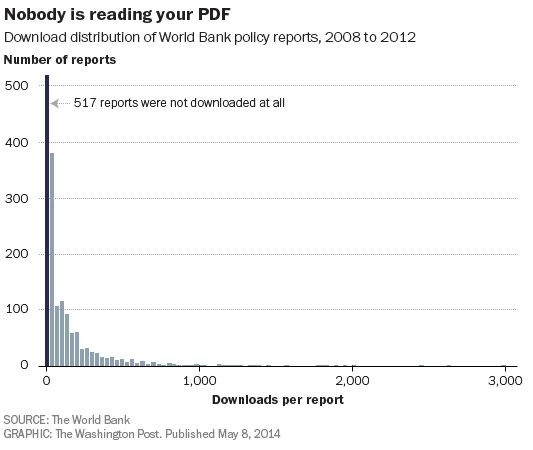Blog • Insights
Dear Think Tanks: No One is Reading Your PDF Report
Earlier this month, Christopher Ingraham of the Washington Post’s WonkBlog posed this troubling question while highlighting findings from a recent World Bank report on the consumption and distribution of their reports. (How meta, right?!)
The report confirms what most digital communication strategists already know and fear: that many PDFs are never downloaded. Some not even once.

This is an unsettling truth for sure, and while Mr. Ingraham shines light on an important issue, his article doesn’t suggest any solutions to the problem. So it begs the question: What should policy-focused organizations be using instead of the PDF format? Here are three things that we think organizations can be doing to move beyond and embrace the new:
- Make the Cloud Your Primary Bookshelf
For decades, the ‘official’ home for a policy brief has been on the shelf. Printed. That made sense when getting your words to someone required picking it up and walking it down the hall. Not anymore. Every “report” should have a unique and permanentUniform Resource Indicator (URI), it should be full length, and it should contain digital assets other than words – video, audio, data, timelines, maps, images, and interactive graphs. - Make Print the by-Product, not the Primary Product
Print still matters, particularly for policy decision makers and influencers, but we’ve tipped, and the primary communications tool for your ideas and insights must now be “digital first.” You can always start small by identifying key reports that are worth the investment to digitize after-the-fact. But to really drive digital adoption, policy-driven organizations need to restructure how they seek funding for programmatic research; they need to demand that digital outputs are not funded as small add-ons, but as primary strategic outputs of the program. - Start to Re-think and Re-Tool Your Publication Process
Organizations need to look closely at their print-centric content production processes and introduce digital planning far sooner in the production process – not something that is started after the report is written. This means educating authors, hiring for new skills, and adopting new technology platforms. Even the largest and most respected publishers, like the New York Times, have recognized this need, and are working hard to move in this direction. The recently leaked “New York Times Innovation Report” is a great behind-the-scenes look at this organizational transformation.
Who’s Doing a Good Job of this Right Now?
Magazine and traditional news publishers have been the fastest to adopt rich, digital longform. Sports Illustrated’s “Long Form” experiment, The Guardian’s NSA Files Decoded, and of course The New York Times’ Snow Fall are all leading edge examples.
Within the NGO world, The Center for Global Development publishes most of their Policy Briefs as full HTML, optimized for any device – desktop, tablet, or phone. Go ahead and browse through their library of reports, and be sure to check out the Commitment to Development Index report, which is a particularly nice example. The Council on Foreign Relations has also invested in the shift to digital first reports with their “Interactives” initiatives, routinely producing pieces like “The Emerging Arctic”, and “China’s Maritime Disputes.”
I’m personally excited for the acceleration of this trend, and my colleagues are as well – one experiment that Jim Cashel is pioneering here at Forum One is a project called “Good Ideas” (GoodIdeas.org). The project is in beta right now, but we’re excited by its vision to create a home for good ideas to be contributed and nurtured, rather than lost and forgotten in the obscurity of the PDF.